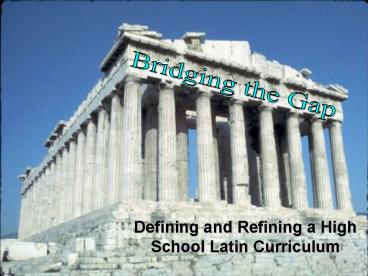Defining and Refining a High School Latin Curriculum - PowerPoint PPT Presentation
1 / 18
Title:
Defining and Refining a High School Latin Curriculum
Description:
Classics Departments. Intermediate proficiency. Focus is on language ... Retrieved July 25, 2006, from http://department.monm.edu/classics/cpl/standards.pdf. ... – PowerPoint PPT presentation
Number of Views:109
Avg rating:3.0/5.0
Title: Defining and Refining a High School Latin Curriculum
1
Bridging the Gap
- Defining and Refining a High School Latin
Curriculum
2
Questions
- Where are the measurable objectives for the
textbook? - What are the district-mandated goals and
objectives for this subject? - How can the teacher best prepare students for the
district-wide assessment? - How does the teacher best prepare students for
success in college-level Latin courses?
3
Research
- School district
- State and national standards
- Ecce Romani textbook
- Classics departments in Tennessee
- Student motivation
- Planning
4
School District
- County-wide Comprehensive Assessment
- No study guide
- No list of objectives covered
- No pacing guide for textbook
5
State and National Standards
- ACTFL The five Cs
- Communication, cultures, connections,
comparisons, and communities - They are not a curriculum guide (1996)
- Tennessee Department of Education Foreign
languages curriculum framework (2006) - ACL (1997)
6
Textbook
- Ecce Romani I II, 3rd ed. (2000)
- Correlated with ACTFL goals
- Objectives are listed in the teachers edition
only - What should the student be able to do at the end
of each chapter?
7
Classics Departments
- Intermediate proficiency
- Focus is on language skills, not culture
- Fast pace
- Success in Latin ? Taking more courses
8
Student motivation
- Curriculum must be meaningful to high school
students - Culture, comparisons, connections
- Sandrock (2002) Language and vocabulary study
alone cannot serve as intrinsic motivators - VanTassel-Baska (2004) Benefits of studying
Latin
9
Planning
- Rutherford (2002) One must plan with the end
result in mind - Pare down list of objectives
- Redefine ACTFL standards in terms students can
understand
10
The Five Cs, redefined
11
Grammar Objectives
- Survey of classics departments
- Areas of deficiency
- Syllabi
- Correlate Ecce with Wheelock
12
Culture Objectives
- Needs differ
- Ways to customize
- Limitations
13
Fructus
- Measurable objectives for I II
- Correlations to state standards Wheelock
- Pacing guide for I, II, and II Honors
- Grammar
- Culture
- Semester Assessments for I II
14
Customizing the Curriculum
- Rutherford (2002) Questions to ask to aid
planning (p. 173) - Is this the right lesson for these students
right now? - Given the school-year time frame, is this
learning experience worthy of the time it will
cost? - Decisions made county-by-county or within school
(Virginia, Georgia)
15
References
- American Classical League. (1997). Standards for
classical language learning. Retrieved July 25,
2006, from http//department.monm.edu/classics/cpl
/standards.pdf. - American Council on the Teaching of Foreign
Languages National Standards in Foreign Language
Education Project. (1996). Standards for foreign
language learning Preparing for the 21st
century. Lawrence, KS Allen Press. - Lawall, G. (ed.). (2000a). Ecce Romani I
teachers guide (3rd ed.). Upper Saddle River,
NJ Prentice-Hall.
16
References
- Lawall, G. (ed.). (2000b). Ecce Romani II
teachers guide (3rd ed.). Upper Saddle River,
NJ Prentice-Hall. - Rutherford, P. (2002). Why didnt I learn this in
college? Teaching and learning in the 21st
century. Alexandria Just ASK. - Sandrock, P. (2002). Creating intrinsic
motivation to learn world languages Electronic
version. Modern Language Journal, 86 (4),
610-612.
17
References
- Tennessee Department of Education. Foreign
languages curriculum framework. Retrieved July
28, 2006, from http//www.state.tn.us/education/ci
/ciforeignlang/index.htm. - VanTassel-Baska, J. (2004). Quo vadis? Laboring
in the classical vineyards An optimal challenge
for gifted secondary students Electronic
version. Journal of Secondary Gifted Education,
15 (2), 56-60. - Wheelock, F.M. (2005). Wheelocks Latin (6th ed.,
revised by R.A. LaFleur). New York
HarperResource.
18
Maximas Gratias Vobis Ago!
- Thank you to Dr. Chris Craig of the University of
Tennessee Classics Department for approving,
supervising, and evaluating this endeavor in the
summer of 2006 as a graduate-level independent
study course. - Questions, comments, and suggestions
- http//www.wcs.edu/bhs - Faculty - Tomayko
Course Documents

